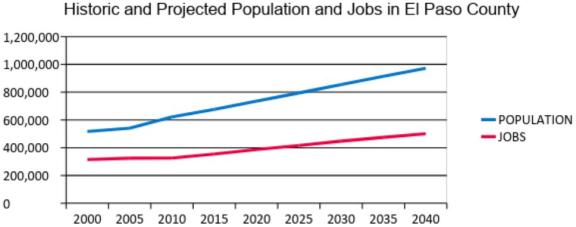
PlanCOS is a guide for the development and growth of the city over the next 20 years. The development of the Comprehensive Plan is authorized in Colorado Revised Statutes (C.R.S. 31-23-206) and the Colorado Springs City Code (Chapter 7, Article 1) to achieve several purposes.
We have created this Plan because it is important to periodically take a broad look at the trends and issues affecting the physical development of our city, to re-establish our land use vision, and to lay out the key steps and priorities to guide us towards this future. There is a lot at stake—in our public investments, our competitiveness, and the quality of our lives. This Plan allows us to make better and more purposeful decisions on major land use applications. It gives us guidance about strategic choices on City initiatives, and it provides an essential framework for the creation and implementation of our more specific plans.
What is a comprehensive plan?
- A guiding document
- A framework for city policies and priorities
- A long-range vision of what we want our city to become
- A tool for making decisions about how that vision should be achieved
- Strategic steps to make the vision a reality
- Targeted and strategic planning of the city
What We Are Planning For
We are planning for a physical development and a land use future that is relatively predictable in some ways, and less certain in others. We will need to revisit and adapt as our local, regional, natural and global environments change. Each of this Plan’s theme-based chapters has its own section on key trends and assumptions, with more detail. Appendix A of this Plan includes Community Snapshots that provide additional context about what we are planning for.
How Long Are We Planning For?
Our planning horizon is between now and 2040, or a little more than 20 years. We need to be thinking about and making some choices at least this far ahead. We are also not expecting this entire plan to last that long. We need to pay regular attention to current trends and experiences, and expect that we will need a minor but important update of this plan every 5 years. A more comprehensive review should occur in 10 years.
Major Trends and Assumptions
Our Population and Employment Projections
Official population and employment projections for cities are supported by information from the State of Colorado, as they are adopted for counties. By 2040, El Paso County is expected to grow to 971,444 persons and 500,482 jobs with increases of 295,266 persons and 145,986 employees respectively during the period from 2015 to 2040. We anticipate Colorado Springs to absorb at least 65% of this growth, which would increase our population to close to 700,000 by 2040.

It is important to recognize there will be fluctuations well above or below the longer term average trends. There is always uncertainty associated with longer term assumptions. Actual growth will be affected by a combination of factors, not all of which can be controlled or influenced by our City. This Plan is designed around these growth assumptions. It is also structured to be adaptable to alternative growth and futures. We intend to be proactive as a city to influence and direct a substantial share of our region’s population and employment growth to occur within city limits.
Our Capacity for Development and Redevelopment
Our city has the land capacity to absorb our expected population and employment growth through 2040, primarily within existing city limits, but also with some targeted annexed areas. While the majority of this capacity is located in Banning Lewis Ranch, other newly developing areas of the city have their own opportunities. Together, the combination of vacant and redevelopable parcels in the generally developed areas of the city represents an opportunity for our community’s development needs.
Table 1 summarizes our assumptions for development capacity. The Areas of Change Map (Map 1) highlights areas we expect to have the most potential for land use change. It includes all potentially developable vacant lands throughout the city, along with assumptions for those areas with a higher relative potential for land use change and redevelopment. Altogether, about 28% of our city is undeveloped. To this total we can and should add already developed areas with a substantial capacity for redevelopment. It is important to recognize that these assumptions of capacity are estimates. Actual experience and rates of development will be variable and uncertain in many cases. For example, there is a national trend toward incorporating accessory dwelling units with supporting covenants as part of the initial planning and approval process for new single-family housing development. This potential additional increase in future development density is not directly accounted for in the capacity tables at this time. What is clear is that the city has capacity for both new development and redevelopment. We expect to regularly update this development capacity information as we move through our planning horizon.
Table 1: Colorado Springs Development and Redevelopment Capacity
| Category | Acres | Dwelling Units | Square Feet* |
|---|---|---|---|
| Vacant Capacity in Banning Lewis Ranch | 22,000 | 65,000 | 41,677,000 |
| Vacant Capacity in other greenfield areas | 6,000 | 13,000 | 9,607,000 |
| Vacant Capacity in core (infill) areas | 6,700 | 16,000 | 15,153,000 |
| Total Vacant Land Capacity | 34,700 | 94,000 | 66,437,000 |
| Single Family Housing Accessory Dwelling Unit Density Increase | N/A | 3,800 | N/A |
| Redevelopment Capacity in Urban Renewal Areas | 300 | 2,000 | 6,606,000 |
| Redevelopment Capacity in Areas of Change | 5,000 | 4,600 | 2,415,000 |
| Total Redevelopment Capacity | 5,300 | 10,400 | 9,021,000 |
| Total Additional Capacity | 40,000 | 104,400 | 75,458,000 |
| Total Capacity | 296,400 | 153,536,000 | |
*Commercial/office/industrial
What is essential to understand about our areas of change map is that it is generalized and not intended to establish bright line distinctions and borders. Put another way:
- Identification as areas of relative land use stability is not intended to imply these areas should not be expected or allowed to undergo land use change at a more local level and scale; and
- Identification as an area of change is not intended to confer an open-ended expectation for development without regard for the character and context of that area.
A Much Older Population
Between 2015 and 2040 our population 65 and older will double with even greater proportional increases in the 85 and older category. Although many of our seniors can expect to “age in place,” this large increase in older residents will create a whole range of impacts and market demands for the built environment.
A More Diverse Population
As our much more diverse younger population gets older, our city will become substantially more diverse overall. We will need to have a city that is built to be responsive to the needs of this new demographic.
Millennials
Millennials (born between about 1981 and 1996) comprise the single largest segment of our population, and are moving to our city at the fastest rate in the country. They are in the process of inheriting our city. Our Plan anticipates this group continuing to do a lot to things differently including living, working, traveling, and communicating.
Multiple Impacts of Technology
Changes in technology continue to have a large effect on how we live in and use our city, and this Plan is created with expectation of more profound impacts in the coming few decades. Vehicles will rapidly transition to being more autonomous. Information, products, and communication will be even less restricted to particular places. Entirely new ways of moving people and goods (e.g. with drones or in vacuum tubes) are possible, and some cases probable.
Opportunities for Attainable Housing
Like many U.S. metro areas, our city has challenges with the mismatch between available incomes and the full real cost of providing services and housing. This Plan assumes these overall income distribution relationships will continue. Therefore, the challenges associated with attainable housing will remain for sizable segments of our citizenry.
Refer to (Appendix A hyperlink) for more details.

